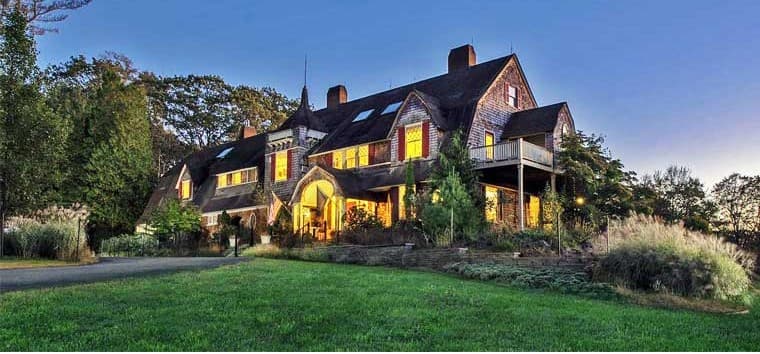The Clayton Family & Mother Polycarpa: A Hidden Chapter in the History of Lake Joseph
Hidden behind the quiet beauty of the Inn at Lake Joseph lies a history far richer than most guests ever realize. Long before today’s visitors arrived for peaceful Catskills getaways, this haven shaped generations of families, Sisters, campers, and community leaders. Among its most remarkable chapters is the Clayton family’s connection, a story uncovered thanks to a recent guest, Michael Clayton, whose memories helped bring this unique past to life.
Origins of the Estate: Thomas Hunt Talmage’s Vision
The history of this property begins in the late 1800s, when Brooklyn businessman Thomas Hunt Talmage commissioned what was intended to be a grand summer estate near the shores of what would become Lake Joseph, New York. His retreat sat on more than 2,000 acres of dense forest and offered deep quiet, a true escape from city life.
Although Talmage passed away before he could fully enjoy it, the property soon found a new purpose, one that would shape its identity for nearly a century.
The Dominican Sisters Arrive at Lake Joseph
 Mother Polycarpa
Mother Polycarpa
Following Talmage’s death, his widow sold the estate to the Dominican Sisters, who were searching for a secluded Catskills location for their growing spiritual mission. Under the leadership of Mother Polycarpa, their revered Mother Superior, the property became Saint Joseph’s, a thriving center of faith, education, and community life.
This chapter is not only significant in the history of the Inn at Lake Joseph it is also deeply intertwined with one family in particular.
The Clayton Family’s Connection to Mother Polycarpa
The Clayton family’s story at Saint Joseph’s begins long before Michael or even his father was born. Michael shared that Mother Polycarpa herself was his grandmother’s aunt, placing the family unusually close to the heart of the Sisters’ work here.
Michael’s grandparents first visited the property in the 1920s. By 1927 the year his father, James Clayton, was born the family had become firmly connected not only to Mother Polycarpa but also to the Dominican Sisters and to the Cardinal. That closeness granted the Claytons a rare place within the life of the property.
When the family visited in the 1960s, they were even welcomed to stay in what had once been the Cardinal’s House, rather than in the guest cottages up on the hill.
James Clayton: From Camper to the Cardinal’s Trusted Aide
As a boy, James Clayton spent his summers at Saint Joseph’s Boys Camp. Over the years he rose through the ranks from camper to counselor, waterfront director, and eventually assistant camp director while he was in medical school.
His time at the camp stretched from the 1930s into the 1950s and early 60s, spanning eras that included colorful moments such as the New York Jets using the property as their spring training site.
But James’s connection ran deeper than his summer roles.
According to Michael, James was often entrusted with discreet responsibilities on behalf of the Cardinal and the Sisters. When influential donors visited from New York City, the Cardinal would host venison dinners. The task of securing that venison fell to young James.
As Michael recalled, the nuns would tell his father:
“Go see Father so-and-so and get absolution… because you’re going to poach some deer.”
James would bring back the venison, the Sisters prepared the meals, and the Cardinal used the weekends to raise funds for Saint Joseph’s expanding mission: the boys’ camp, the girls’ camp, the convent school, and later the girls’ academy.
Life at Saint Joseph’s During the Golden Years
 Image of Mother Polycarpa hall Camp Saint Joseph for Girls
Image of Mother Polycarpa hall Camp Saint Joseph for Girls
James Clayton witnessed the camp at its height, when buses from Brooklyn delivered hundreds of children each summer: around 250 boys on one side of the property, and a similar number of girls on the other.
He continued returning well into the 1960s and early 1970s, even as the camps eventually began to decline. James passed away in 2015, but the legacy he carried, the stories, the service, and the trust placed in him by the Sisters, remains closely tied to the history of Lake Joseph.
A Legacy That Still Echoes Across Lake Joseph
Through the Clayton family, we gain a rare glimpse not only into the daily life of Saint Joseph’s, but into the very heartbeat of Mother Polycarpa’s mission: faith, community, mentorship, and dedication to the young people who passed through this extraordinary place.
Today, as the Inn at Lake Joseph continues to welcome guests seeking relaxation, adventure, and connection in the Catskills, these stories form the foundation of something enduring. The lake, the forest, and even a few of the remaining structures still carry echoes of the Sisters, the campers, and families like the Claytons who helped shape the spirit of this land.
By preserving and sharing these histories, new owners Rom and Maria honor the generations who came before and ensure their legacy remains part of the story here at the Inn at Lake Joseph.
Acknowledgements
 Clayton family standing in front of the old grotto with the altar dedicated in memory of Cardinal Patrick Joseph Hayes from left to right: Robert Ballou, Susan 'Clayton' Ballou, Michael Clayton, Kathryn Clayton
Clayton family standing in front of the old grotto with the altar dedicated in memory of Cardinal Patrick Joseph Hayes from left to right: Robert Ballou, Susan 'Clayton' Ballou, Michael Clayton, Kathryn Clayton
A special thank-you to Michael Clayton and the entire Clayton family for generously sharing their stories, memories, and family history. Their contributions brought this chapter of Lake Joseph’s past vividly to life. We are also deeply grateful to Sullivan County Historian John Conway for his insight and guidance, which helped ensure the accuracy and preservation of this remarkable story.
Interested in experiencing the history of Lake Joseph for yourself?
Stay at our quiet, secluded lakeside Inn — where the stories of the past still echo through the forest, the trails, and the peaceful spaces the Sisters once walked.

